It’s impossible to ignore the current supply chain crisis, especially in the United States. As inflation rises and consumers face higher prices and shortages in the upcoming holiday season, ships continue to stack in harbors waiting to offload goods.
How did the supply chain become such a mess?
The problem began with pandemic-related factory shutdowns in China, which led to shortages for raw materials, components, and finished goods manufactured there. At the same time, many businesses shifted to working from home and school systems closed, fueling increased demand for larger houses, home gadgets, computer and communications gear, furniture, toys, and recreational equipment.
Because of the pandemic, manufacturers could not meet demand. Labor and material shortages, intermittent plant closures, and shipping delays caused shortages around the world. Transportation systems were strained by restrictions on air travel and quarantine requirements on vessel crews and interstate truck drivers.
As countries swung back to higher levels of economic activity, ports could not process the increased shipping volumes. The entire transportation and distribution system was not built to add capacity at the rate the flow was growing. The result was long delays, with ships anchored for weeks outside major ports and a shortage of maritime containers that were stuck on waiting vessels and could not be reloaded and shipped.
Shipping takes longer and is more expensive
Importing and exporting goods has long been an industry with thin margins for error. Excess time and excess inventory are expensive. Capacity is theoretically sufficient, but the journey from Asia to the United States or North Europe now has an average delay of 14 to 18 days, leaving containers on board for even longer.
The twin ports of Long Beach and Los Angeles together process 40 percent of the shipping containers brought into the United States. The number of cargo ships off the Port of Long Beach is up 466% this year, with unloading times varying from 8 days to a month. There are similar reports of delays at major ports in Hamburg, Hanoi, Barcelona, and Busan.
At the end of October, the price of ocean transport was seven times the pre-pandemic rate and more than 100 trains, each at least three miles long, were leaving the Los Angeles basin each day. The cost to ship a container from Asia to the United States’ East Coast climbed from around $1,400 per container to around $20,000.
Preparing for the next supply chain crisis
The only true way out of the crisis is to end the COVID-19 pandemic. After New Year’s, assuming there are no pandemic surges, we should begin to see some normalization. If new lockdowns and new restrictions are implemented, the shipping crisis will continue.
Either way, there are steps you can take to help bolster your supply chain before the next crisis occurs.
Supply chain mapping
One way to avoid supply chain breakdowns is to identify vulnerabilities using supply chain mapping. This process involves combing through your entire supply chain to identify the level of risk associated with each vendor and what the economic impact would be if each resource was lost.
Once you have this information, you can use it to diversify your vendors or stockpile necessary resources for a rainy day. This exercise will also help you identify areas that can be automated, highlighting software that could ease operations within your supply chain.
Diversifying vendors
Supplier diversification helps decrease risk. Instead of relying on one supplier, you add secondary suppliers to ensure continuity if one vendor has a problem. For example, some North American organizations trying to reduce dependency on China are finding new partners in Central and South America. That way, if a container ship gets stuck in the Suez Canal, they have suppliers close by and are less affected by market events in Asia.
Upgrading technology
Modern software offers the flexibility to switch between vendors and mitigate supply chain bottlenecks more easily. From generating better data and insights to automating manufacturing processes where robots can take the place of social-distanced humans, the right software can drive operational efficiencies that will help keep your supply chain on track. Software that can manage data, control automated processes, and visualize important business transactions in real time can help you avoid supply chain disasters.
Investing in a modern commodity management system provides real-time visibility across your entire commodity supply chain, so you know the moment problems arise and can react quickly. What-if scenarios enable you to evaluate possible courses of action before you have to act, so you can plan ahead and prepare for potential disruptions.
By the second quarter of 2022, most analysts predict the supply chain crisis will end. Both manufacturers and suppliers will have a better understanding of actual demand versus pandemic-related demand fluctuations. Suppliers will have had the time to invest in expanded capacity in segments where they expect demand to stay high. If another supply chain disruption occurs, evaluating your supply chain now may help you mitigate the impact.
Contact iRely today to learn how we can help you modernize and optimize your commodity supply chain.
